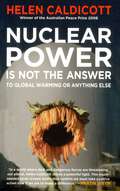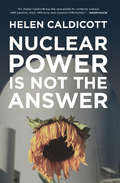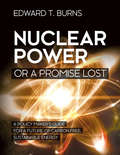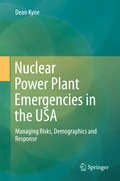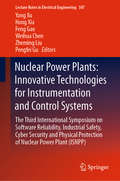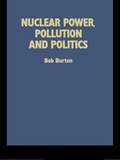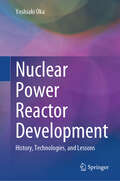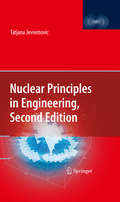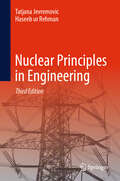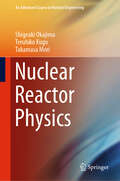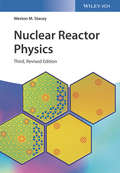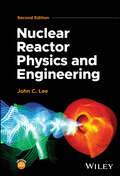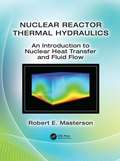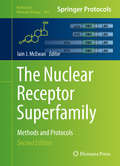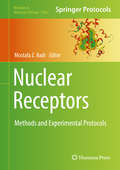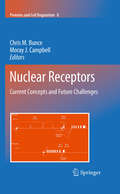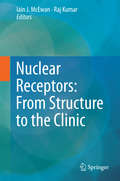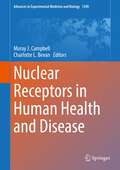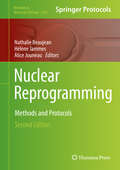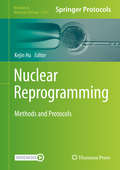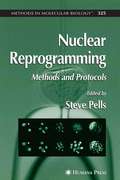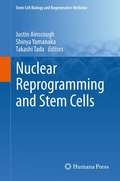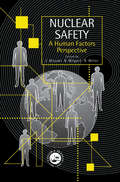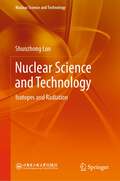- Table View
- List View
Nuclear Power Is Not The Answer To Global Warming Or Anything Else
by Helen CaldicottIn this revealing examination of the costs and consequences of nuclear energy, world-renowned antinuclear spokesperson Helen Caldicott uncovers the facts that belie the nuclear industry propaganda: nuclear power contributes to global warming; the true cost of nuclear power is prohibitive, with taxpayers picking up most of the tab; there's simply not enough uranium in the world to sustain nuclear power over the long term; and the potential for a catastrophic accident or a terrorist attack far outweighs any benefits. Trained as a physician and thoroughly versed in the science of nuclear energy, the bestselling author of Nuclear Madness and Missile Envy here turns her attention from nuclear bombs to nuclear lightbulbs. As she makes meticulously clear in this essential book, the world cannot withstand either.
Nuclear Power Is Not the Answer
by Helen CaldicottThe renowned antinuclear activist delivers a &“frighteningly convincing argument&” against nuclear energy as a solution to climate change (Publishers Weekly). In a world torn apart by wars over oil, politicians have stepped up their search for alternative energy sources—and their leading choice is nuclear energy. But nuclear energy&’s popularity as a green alternative is based on misinformation. People claim that nuclear-powered electricity does not cause global warming or pollution, that it is inexpensive, and that it is safe. These claims, as Helen Caldicott demonstrates, are untrue. In Nuclear Power Is Not the Answer, Caldicott digs beneath the nuclear industry&’s propaganda to examine the actual costs and environmental consequences of nuclear energy. In fact, nuclear power does contribute to global warming; the cost is prohibitive, with taxpayers picking up most of the tab; there&’s not enough uranium in the world to sustain it over the long term; and the potential for a catastrophic accident or a terrorist attack far outweighs any benefits. In concluding chapters, Caldicott details alternative sustainable energy sources that are the key to a clean, green future.
Nuclear Power or a Promise Lost: A Policy Maker's Guide for a Future of Carbon Free, Sustainable Energy
by Edward T. BurnsThis book captures the status of current electrical energy markets including the principal forces affecting decisions on selecting an energy source. It represents a seminal work that lays out the electrical energy decision tree for selecting an energy sou
Nuclear Power Plant Emergencies in the USA: Managing Risks, Demographics and Response
by Dean KyneManaging nuclear power emergencies is significantly different from managing other types of emergencies, including fire, flood, and other disasters because nuclear disaster management requires special technical skills and a rigid protocol which outlines detailed steps and procedure before an evacuation announcement could be made. It was evident that the impacts from a nuclear power core-meltdown accident were immerse, irreversible, and inevitable, as evident by evaluating the three historic core-meltdown accidents, namely Three Mile Island in 1997, Chernobyl in 1986, and Fukushima Daiichi in 2011. The three options for minimizing the risks associated with NPPs are suggesting elimination of all NPPs in operation in the United States, transforming inevitable risks to evitable risks, and transforming the current radiological plan into an effective emergency management plan. Being the latter option is the only viable one, this book provides a comprehensive understanding on effectively managing nuclear power emergencies in the U.S. The book presents detailed analysis on effectively managing nuclear power emergencies. In an attempt to illustrate minimizing the risks, factual answers to the key questions surrounding managing nuclear disasters are outlined. What are the risks associated with the nuclear power plants (NPP)? What are the problems associated with managing nuclear power core-meltdown accidents in the three historic accidents? Where are the geographical locations of the 99 commercial reactors in the U.S? Who are those exposed to potential risks associated with the NPPs? How could a projection of radioactive plume dispersion pathway be carried out using a spatial computer code, such as the Radiological Assessment Systems for Consequence Analysis (RASCAL) in case of a core-meltdown accident? Where would the radioactive plume go given weather conditions? Who are more likely to be exposed to the high level radiation dose during the core-meltdown accident? What are the issues with the current radiological emergency plan?
Nuclear Power Plants: The Third International Symposium on Software Reliability, Industrial Safety, Cyber Security and Physical Protection of Nuclear Power Plant (ISNPP) (Lecture Notes in Electrical Engineering #507)
by Yang Xu Hong Xia Feng Gao Weihua Chen Zheming Liu Pengfei GuThis book is a compilation of selected papers from the 3rd International Symposium on Software Reliability, Industrial Safety, Cyber Security and Physical Protection of Nuclear Power Plants, held in Harbin, China on 15th–17th August 2018. The symposium discussed the status quo, technical advances and development direction of digital instrument control technology, software reliability, information security and physical protection in the process of nuclear power development. Offering technical insights and know from leading experts, this book is a valuable resource for both practitioners and academics working in the field of nuclear instrumentation, control systems and other safety-critical systems, as well as nuclear power plant managers, public officials, and regulatory authorities.
Nuclear Power, Pollution and Politics
by Bob BurtonPlaces the environmental issues related to the production of nuclear power in their political context. It evaluates the extent of nuclear pollution, in comparison with other forms of power, and looks at the future of energy.
Nuclear Power Reactor Development: History, Technologies, and Lessons
by Yoshiaki OkaThis book offers a comprehensive exploration of the history and development of power reactors worldwide, from their inception to the present day. It provides an in-depth analysis of light water reactors and their global technology, while also delving into the evolution of gas-cooled, heavy water, liquid metal-cooled, aerospace, and nuclear fusion reactors. By examining past advancements, this book equips readers with the insights necessary to apply lessons learned to future reactor development and utilization. Key concepts include the dominance of light water reactors in the global market, the progression of nuclear fuel cycle technologies, and the economic and political aspects of plutonium utilization. The book also addresses critical questions such as the potential depletion of uranium resources and the characteristics of Generation III and IV reactors. With contributions from government agencies and international organizations, this work is a must-read for those seeking a thorough understanding of nuclear reactor history and future challenges. Intended for graduate students, university faculty, researchers, industry professionals, and anyone with a keen interest in nuclear power, this book serves as a vital resource for understanding the complexities of nuclear reactor development and the broader implications for society. The translation was done with the help of artificial intelligence. A subsequent human revision was done primarily in terms of content.
Nuclear Principles in Engineering
by Tatjana JevremovicNuclear engineering plays an important role in various industrial, health care, and energy processes. Modern physics has generated its fundamental principles. A growing number of students and practicing engineers need updated material to access the technical language and content of nuclear principles. "Nuclear Principles in Engineering, Second Edition" is written for students, engineers, physicians and scientists who need up-to-date information in basic nuclear concepts and calculation methods using numerous examples and illustrative computer application areas. This new edition features a modern graphical interpretation of the phenomena described in the book fused with the results from research and new applications of nuclear engineering, including but not limited to nuclear engineering, power engineering, homeland security, health physics, radiation treatment and imaging, radiation shielding systems, aerospace and propulsion engineering, and power production propulsion.
Nuclear Principles in Engineering
by Tatjana Jevremovic Haseeb ur RehmanSeveral emerging application areas are driving a revival in nuclear engineering, including new nuclear reactor designs (advanced water-cooled reactors, small modular reactors, and microreactors) and their various applications beyond electricity production and a revolution in nuclear medicine, nuclear space exploration, hydrogen production, and homeland security. This fully updated introductory textbook provides students and practitioners with the fundamentals of nuclear principles in engineering for a thorough understanding of physical processes relating to neutron physics, nuclear structures, and radiation interactions. To comprehend physical phenomena, hands-on computational exercises supported by mathematical details and real-life examples are provided to communicate the nuclear principles concepts. A new chapter details the evolution of nuclear power plants, explaining the modern-day technologies based on design details linked to the basic principles of nuclear engineering. In addition, every chapter is supplied with the problems solutions and answers. Nuclear Principles in Engineering, Third Edition, is written for students, engineers, physicists, and scientists who need up-to-date information on basic nuclear concepts and calculation methods, and will serve as an invaluable resource for training programs in the nuclear sector.
Nuclear Reactor Physics (An Advanced Course in Nuclear Engineering #5)
by Shigeaki Okajima Teruhiko Kugo Takamasa MoriThis book covers introductory subjects including fundamental principles of nuclear reactions with neutrons, fundamentals of nuclear fission chain reactions, basic concepts of criticality, and static characteristics based on diffusion approximation in neutron transport. The chapters address topics ranging from neutron moderation from fission to thermal energy ranges and heterogeneity effects in neutronics. Readers will find elementary and qualitative descriptions and also mathematical expressions including approximations, derivations and analytical solutions for an understanding of the basic principles of nuclear reactor physics. This book is part of a series entitled An Advanced Course in Nuclear Engineering and provides an accessible introduction to the core discipline of nuclear engineering: nuclear reactor physics. It will therefore appeal to engineers in nuclear engineering as well as to university students and others seeking to learn entry-level reactor physics.
Nuclear Reactor Physics
by Weston M. StaceyThis third, completely revised edition of the textbook retains the proven concept of complete and balanced coverage of the topic. The first part looks at basic reactor physics, including, but not limited to nuclear reactions, diffusion theory, reactor dynamics, fuel burnup and reactor safety. The second part then deals with such physically and mathematically more advanced topics as neutron transport theory, resonance absorption and neutron thermalization. For ease of reference, the detailed appendices contain nuclear data, useful mathematical formulas, an overview of special functions as well as an introduction to matrix algebra and Laplace transforms. With its focus on conveying the in-depth knowledge needed by advanced student and professional nuclear engineers, this text is ideal for use in numerous courses, including nuclear reactor physics, advanced nuclear reactor physics, neutron transport theory, nuclear reactor dynamics and stability, and nuclear reactor fuel cycle physics.
Nuclear Reactor Physics and Engineering
by John C. LeeEssential guide to analyzing nuclear energy systems, with focus on reactor physics, fuel cycle, system dynamics, thermal-hydraulics, and economics. Nuclear Reactor Physics and Engineering highlights efforts in utilizing low enrichment uranium fuel as a substitute for carbon-based fuels in energy generation and provides an overview of important aspects of nuclear reactor physics utilizing the neutron diffusion equation for major reactor designs and MATLAB software for system analysis, with exercises illustrating key points and design parameters as supplementary material. This revised and updated Second Edition reflects key findings of the 2023 National Academy of Sciences (NAS) report and discusses physical and engineering characteristics of advanced nuclear reactors, especially in the form of small modular reactors that have the potential to provide enhanced safety and economics, as well as effective long-term management of used nuclear fuel in geological repositories. Key topics explored in the updated edition of Nuclear Reactor Physics and Engineering include: Impact of the use of high-assay low enrichment uranium (HALEU) fuel as a new efficient nuclear fuelAdvantages resulting from combined uses of light water reactor and sodium-cooled fast reactor with fuel reprocessingFundamental nuclear reactor physics, nuclear reactor system analysis, and lattice physics analysis for reactor cores Nuclear fuel cycle analysis, nuclear plant simulation and control, and management of used nuclear fuelEconomic analysis of nuclear electricity and thermal-hydraulic analysis of nuclear systems. With a wealth of all-new information detailing the state of the art in the field, Nuclear Reactor Physics and Engineering is an invaluable reference on the subject for undergraduate and graduate students in nuclear engineering, as well as practicing engineers involved with nuclear power plants.
Nuclear Reactor Thermal Hydraulics: An Introduction to Nuclear Heat Transfer and Fluid Flow
by Robert E. MastersonNuclear Thermal-Hydraulic Systems provides a comprehensive approach to nuclear reactor thermal-hydraulics, reflecting the latest technologies, reactor designs, and safety considerations. The text makes extensive use of color images, internet links, computer graphics, and other innovative techniques to explore nuclear power plant design and operation. Key fluid mechanics, heat transfer, and nuclear engineering concepts are carefully explained, and supported with worked examples, tables, and graphics. Intended for use in one or two semester courses, the text is suitable for both undergraduate and graduate students. A complete Solutions Manual is available for professors adopting the text.
The Nuclear Receptor Superfamily
by Iain J. McewanActing principally to control patterns of gene expression, nuclear receptors play vital roles during embryonic development and in the regulation of metabolic and reproductive functions in adult life, which proves this superfamily of ligand-activated transcription factors to be a crucial part of biological life. In The Nuclear Receptor Superfamily: Methods and Protocols, expert researchers describe a range of molecular, structural and cell biological techniques currently used to investigate the structure-function of nuclear receptors, together with experimental approaches that may lead to new therapeutic strategies for treating nuclear receptor-associated diseases. Written in the highly successful Methods in Molecular BiologyTM series format, the chapters in this volume contain brief introductions to the topics, lists of the necessary materials and reagents, step-by-step, readily reproducible laboratory protocols, as well as notes from the experts to highlight tips on troubleshooting and avoiding known pitfalls. Cutting-edge and easy to use, The Nuclear Receptor Superfamily: Methods and Protocols provides beneficial and time-saving guidance for all those undertaking research in this ever-growing field of study.
Nuclear Receptors: Methods and Experimental Protocols (Methods in Molecular Biology #1966)
by Mostafa Z. BadrThis volume presents valuable techniques for studying the class of ligand-activated transcription factors known as nuclear receptors. After a brief overview of the history of the field, chapters cover methods to detect the receptors and their mRNAs in various tissues, protocols to characterize nuclear receptor modulators and activities, their signaling and roles in certain pathogenesis, molecular modeling of nuclear receptor-ligand interactions, as well as the utility of informatics in the field of nuclear receptors. Written in the highly successful Methods in Molecular Biology series format, chapters include introductions to their respective topics, lists of the necessary materials and reagents, step-by-step, readily reproducible laboratory protocols, and tips on troubleshooting and avoiding known pitfalls. Authoritative and cutting-edge, Nuclear Receptors: Methods and Experimental Protocols seeks to aid researchers working toward furthering our understanding of these vital receptors and their role in numerous pathological conditions.
Nuclear Receptors
by Moray J. Campbell Chris M. BunceIn 1890 a case of myxedema was treated in Lisbon by the implantation of a sheep thyroid gland with the immediate improvement in the patient's condition. A few years later, medications for the then ill-explained condition of the menopause included tablets made from cow ovaries. In the first quarter of the 20th century the identification of vitamin D, and its sunlight driven production in skin, paved the way to the elimination of rickets as a major medical problem. Twenty years or so later, Sir Vincent Wigglesworth established the endocrine basis of developmental moulting in insects, arguably the most commonly performed animal behaviour on Planet Earth. A paradigm that would unify these disparate observations arose between 1985 and 1987 beginning with the identification of the glucocorticoid receptor and the nuclear receptor super-family. What follows is a timely and positive manifestation of the capacity, productivity and value of international human scientific endeavour. Based on intrigue, lively competition and cooperation a global effort has rapidly fostered a school of biology with widespread ramifications for the understanding of metazoan animals, the human condition and the state of the planet. This book is the first this century to try and capture the spirit of this endeavour, to depict where the field is now and to identify some of the challenges and opportunities for the future.
Nuclear Receptors: From Structure to the Clinic
by Iain J. Mcewan Raj KumarNuclear Receptors focuses on the structural analysis of nuclear receptors from the initial work using isolated protein domains to the more recent exciting developments investigating the conformational shape of full-length receptor complexes. The book also reviews the structure of key nuclear receptor co-regulatory proteins. It brings together, for the first time, a comprehensive review of nuclear receptor structure and the importance of receptor conformation underpinning allosteric regulation by different ligands (hormone, drugs, DNA response elements, protein-protein interactions) and receptor activity. The nuclear receptor superfamily, including receptors for steroid hormones and non-steroid ligands, are pivotal to normal physiology, regulating processes as diverse as reproduction, metabolism, the immune system and brain development. The first members of the family were cloned over 25 years ago, which heralded in the idea of a superfamily of intracellular receptor proteins that bound small molecule ligands: classical steroid hormones, vitamins, fatty acids and other products of metabolism. These signals are then transmitted through multiprotein receptor-DNA complexes, leading to the regulation of target genes, often in a cell-selective manner. The cloning of the receptor cDNAs also ushered in an era of unparalleled analysis of the mechanisms of action of these ligand-activated transcription factors.
Nuclear Receptors in Human Health and Disease (Advances in Experimental Medicine and Biology #1390)
by Moray J. Campbell Charlotte L. BevanThis book addresses and dissects the roles and crosstalk mechanisms for the 48 human nuclear receptors (NR) in human health and disease. After a State-of-the-Art introduction by an undisputed and celebrated field leader to provide an overview of the field and its significance, chapters are organized into six sections. The first three sections discuss NR roles in Reproduction & Development, Metabolism and Central Systems. These present to the reader our current understanding of NR signaling in the development and functioning of the reproductive system; the roles in the regulation of energy metabolism; and how NR signaling is more widely integrated into systemic functions from calcium flux to circadian rhythm. The subsequent three sections dissect how aberrant NR functions drive Cancer; how new insights into Genomic Interaction are helping to reveal how NR disruption drives disease; and finally, how Translational Efforts are exploiting this understanding from developing novel NR ligands to establishing how underlying genetic variation impacts NR function. Within these sections the chapters also illustrate emerging understanding of how the epigenome and non-coding genome combine to regulate NR function and impact dysfunction. Increasingly these insights cross-fertilize over cell and disease boundaries and it is unsurprising that NR are being explored in novel and new arenas such as the context of neurological disorders and depression. Thus, there is wide scope for re-purposing of licensed drugs and development of new NR-targeting therapies for a host of conditions and diseases. This unique book brings together many of the leading figures in NR research from across the globe, to discuss emerging roles and their implications for human health and disease. It summarizes the state of the art and shows signposts for future research to further shape this influential field.
Nuclear Reprogramming
by Nathalie Beaujean Hélène Jammes Alice JouneauNuclear Reprogramming: Methods and Protocols, Second Edition includes not only classic methods to perform nuclear transfer in different species but also several techniques to assess the early and late development of the reconstructed embryos, at the cellular, molecular, and epigenetic level. Over the past several years, many technical improvements have been made to improve somatic cell nuclear transfer (SCNT) efficiency, all of which are reflected in the detailed chapters of this fully revised collection. Written in the highly successful Methods in Molecular Biology series format, chapters include introductions to their respective topics, lists of the necessary materials and reagents, step-by-step, readily reproducible laboratory protocols, and tips on troubleshooting and avoiding known pitfalls. Authoritative and up-to-date, Nuclear Reprogramming: Methods and Protocols, Second Edition will be of interest not only to cloners but also to researchers concerned with studying the development of embryos.
Nuclear Reprogramming: Methods and Protocols (Methods in Molecular Biology #2239)
by Kejin HuThis volume provides basic and advanced protocols on somatic cell nuclear transfer, induced pluripotent stem cells, and direct reprogramming of somatic cells into different functional cells. Chapters guide readers through methods on standardized procedures for characterization of induced pluripotent stem cells, as well as those for preparation of materials required for induction of pluripotent stem cells. Written in the highly successful Methods in Molecular Biology series format, chapters include introductions to their respective topics, lists of the necessary materials and reagents, step-by-step, readily reproducible laboratory protocols, and tips on troubleshooting and avoiding known pitfalls. Authoritative and cutting-edge, Nuclear Reprogramming: Methods and Protocols aims to ensure successful results in the further study of this vital field.
Nuclear Reprogramming
by Steve PellsA wide-ranging collection of readily reproducible methods for performing nuclear reprogramming by nuclear transfer in several different species, by fusion through both chemical treatment and electrically shocking cells, and by in vivo treatment of cells with cell extracts. Several methods of monitoring nuclear reprogramming are also presented, including the use of transgenic markers, activation of telomerase as an ES-specific marker, light and electron microscopic observation of structural changes in the nucleus, and verification of surface marker expression and the differentiation potential of stem cells. Biochemical methods are provided for the examination of chromatin protein modifications, nucleosomal footprinting, transcription factor binding, and the study of DNA methylation changes both at the specific locus level and at the level of the whole nucleus.
Nuclear Reprogramming and Stem Cells
by Shinya Yamanaka Justin Ainscough Takashi TadaResearch into the field of stem cell biology has developed exponentially over recent years, and is beginning to offer significant promise for unravelling the molecular basis of a multitude of disease states. Importantly, in addition to offering the opportunity to delve deeply into the mechanisms that drive disease aetiology the research is realistically opening the doors for development of targeted and personalized therapeutic applications that many considered, until recently, to be nothing more that a far fetched dream. This volume provides a timely glimpse into the methods that have been developed to instigate, and the mechanisms that have been identified to drive, the process of nuclear reprogramming, chronicling how the field has developed over the last 50-60 years. Since the early 1950s a small number of notable experiments have provided significant impetus to the field, primarily the demonstration of reprogramming ability, first by the complex cytoplasmic milieu that constitutes the amphibian egg, then that of the mammalian egg, and finally that of the mammalian embryonic stem cell. Most recently, the demonstration that a limited pool of defined molecules is capable of reprogramming a multitude of cell types has provided massive impetus and facilitated transition towards realistic therapeutic application. We have therefore reproduced some of the key articles that elegantly document these dramatic stages of development of the field in an inclusive appendix to the book, for the benefit of readers keen to investigate the history of how the field of stem cell biology has evolved. Owing to the ever broadening nature of this field, and the incredible rate at which it is evolving, the main content of this volume focuses on areas that have shown significant movement in recent years, are most likely to translate into personalized therapeutic application, and thus provide greatest potential for significant impact on human health in the not too distant future. We recognize that research into many other disease states and cell types are all equally worthy of discussion. We would therefore like to acknowledge those researchers involved whose work we have not been able to include in this volume. Nuclear Reprogramming and Stem Cells will serve as a valuable resource for all researchers in the field of stem cell biology, including those just setting out on their career path as well as those already established in the field.
Nuclear Risks and Arms Control - Problems and Progresses in the Time of Pandemics and War: Proceedings of the XXII Edoardo Amaldi Conference, Accademia Nazionale dei Lincei, Rome, Italy, April 6–8, 2022 (Springer Proceedings in Physics #291)
by Paolo Cotta-Ramusino Micah Lowenthal Luciano Maiani Enza PellecchiaThis open access book is based on the conference organised by Accademia dei Lincei and the US National Academy of Sciences and supported by the Italian Ministero degli Affari Esteri. It was attended by about 60 scientists and researchers from 13 countries, including, besides Europe, Iran, Israel, Iraq, Pakistan, India, Japan, Russian Federation and the USA. In an international scenario shaken by the uncertainties of the pandemic and the war between Russia and Ukraine, dialogue and scientific collaboration are confirmed to be precious tools to enhance nuclear safety, security and non-proliferation. The urgency to open peace discussions in Ukraine was emphasised by all participants, and the belief that science can make an essential contribution to peace construction was reaffirmed. Current challenges (some new, such as autonomous weapons and the use of artificial intelligence for war purposes) are discussed and attempts made to identify possible solutions and future improvements, including in the field of sustainable energy development.
Nuclear Safety: A Human Factors Perspective
by Bernhard Wilpert Jyuji Misumi Rainer MillerFor many years, as a direct result of international governmental concern, the nuclear power industry has been at the forefront of industrial safety. This text represents a cross-disciplinary look at the human factors developments in this industry, with wider applications for the entire industrial sector. Technical, psychological and social aspects
Nuclear Science and Technology: Isotopes and Radiation (Nuclear Science and Technology)
by Shunzhong LuoThis textbook highlights the fundamentals, applications and research frontiers of the civil-use non-power nuclear technology, especially the radioisotopes and radiation technology. The wide scope of applications and the active research in the subject field calls for a comprehensive textbook that not only explains the basic principles but also links the fundamentals to the various application fields. The book systematically leads students from isotope preparation, to nuclear analysis, and to the civil applications in areas such as chemical engineering, agriculture, medicine, environmental protection and materials modification. The application in the energy field is briefly introduced. The book can be used as good teaching materials for upper undergraduate and graduate students in nuclear science and technology. It is also a handy reference book for researchers and engineers in the above mentioned fields.
